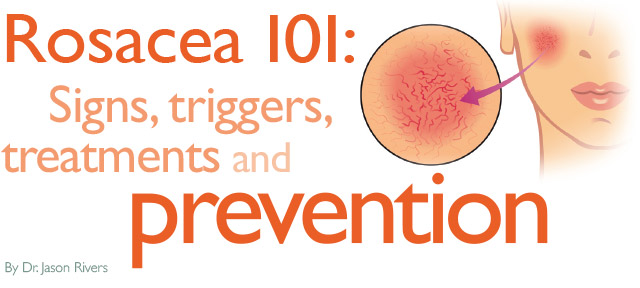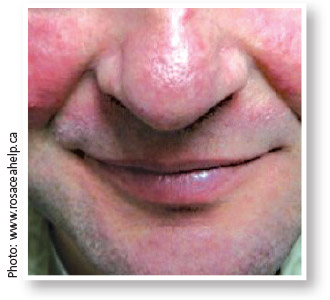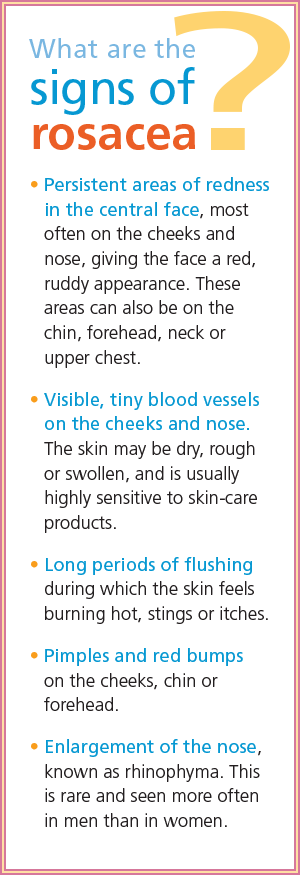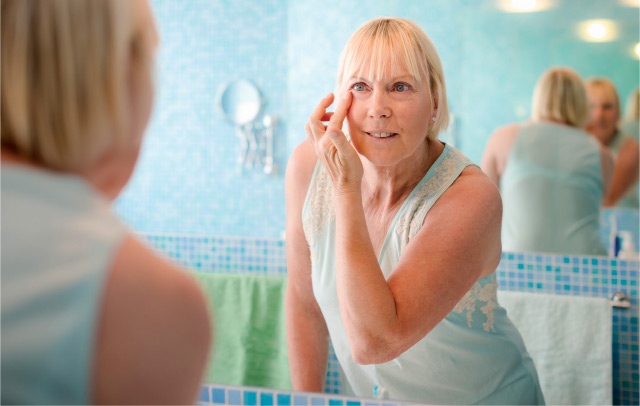
 Often, the first time a person hears the word “rosacea” (row-zay-sha) is when a doctor tells them they have this common skin condition. Rosacea, a skin disease causing facial redness, affects more than two million adults in Canada. However, many people continue to be unaware they are affected by it, and a 2015 survey conducted by the Acne and Rosacea Society of Canada (www. RosaceaHelp.ca) found that seven in 10 Canadians were unable to recognize central facial redness as a common feature of rosacea.
Often, the first time a person hears the word “rosacea” (row-zay-sha) is when a doctor tells them they have this common skin condition. Rosacea, a skin disease causing facial redness, affects more than two million adults in Canada. However, many people continue to be unaware they are affected by it, and a 2015 survey conducted by the Acne and Rosacea Society of Canada (www. RosaceaHelp.ca) found that seven in 10 Canadians were unable to recognize central facial redness as a common feature of rosacea.
 What is rosacea?
What is rosacea?
Rosacea is a common, chronic, inflammatory skin condition causing redness on the central face. It often begins as a tendency to flush and blush. In time, persistent areas of redness appear on the cheeks and nose, and there may also be pimples and red bumps. Even the eyes may be affected. See “What are the Signs of Rosacea?” for more information.
What causes rosacea?
The causes are unknown. However, research is ongoing and the following pathways are thought to be involved:
- a faulty immune system
- an impaired skin barrier function
- genes
- problem with the vascular system
- flaws in the nervous system
- a higher prevalence of microscopic Demodex mites or a sensitivity to these organisms Risk factors Studies show some people have a higher risk for rosacea.
These include:
- those with fair skin, including people of Celtic or Northern European descent, giving rosacea the nickname “Curse of the Celts”
- women more so than men
- those with a family history of the condition
- people with extremely sensitive skin
Treatment options
While there is no cure for rosacea, there are safe and effective treatments that can bring rosacea under control and minimize its effects.
Facial redness, flushing and visible blood vessels: Medical options include topical (applied to the skin) treatments such as brimonidine, which reduces facial redness for up to 12 hours. Laser and lightbased treatments have also been used successfully for many years to treat the visible blood vessels, facial redness and flushing of rosacea. Several treatment sessions are often needed.
Facial redness, pimples and red bumps: There are various topical treatments that may be used alone or in combination with oral therapies. These include azelaic acid, ivermectin, metronidazole and calcineurin inhibitors. Oral treatments include antibiotics, low-dose doxycycline and low-dose isotretinoin.
Ocular rosacea: Treatment here includes the use of artificial tears, gentle eye and eyelid care, and, in some cases, oral antibiotics.
Skin thickening with nose or chin enlargement: Surgery with lasers or with electrocautery or excision are the treatment options for this uncommon form of rosacea.

 Triggers and self-care
Triggers and self-care
Rosacea can be kept at bay with the use of self-care measures such as good skin care and avoidance of everyday triggers that set off the flushing, blushing and other skin changes of rosacea. Common rosacea triggers include sunlight, hot drinks, alcohol, spicy foods, hot baths or showers, and exercise. Often an increase in body temperature is involved. Stress, certain skin-care products, and medications such as potent topical steroids may also trigger a rosacea flare-up.
Many patients with rosacea have highly sensitive skin that is easily irritated. Look for gentle, fragrance free products that do not contain alcohol. Sunscreens are an important part of skin care for those with rosacea, offering protection against the sun’s rays and helping to prevent flare ups. Moisturizers are essential to help keep the skin hydrated and for the relief of skin discomfort.
Emotional effects
Signs of rosacea (facial redness, visible blood vessels, pimples and red bumps) can result in low self-esteem, embarrassment, frustration, social anxiety and depression. Most people with rosacea have a feeling of being stigmatized, branded or shamed for having a red face. Those with rosacea have five times the risk of developing depression compared to the general population. 75 per cent of those with rosacea report low self-esteem.
Skin care and treatments can bring rosacea under control and greatly reduce the visible signs of the disease. Studies have shown people feel happier, healthier and more confident as their rosacea improves. Visit www.rosaceahelp.ca.
Jason Rivers, MD, FRCPC, FAAD, is a Vancouver dermatologist. He is medical director at Pacific Dermaesthetics, a clinical professor of dermatology at the University of British Columbia, and president of the Acne and Rosacea Society of Canada (www.RosaceaHelp.ca and www.AcneAction.ca).
